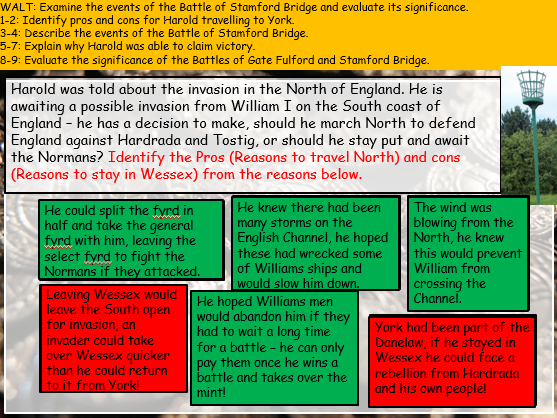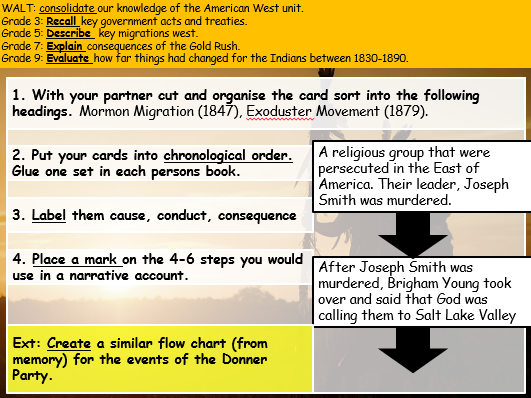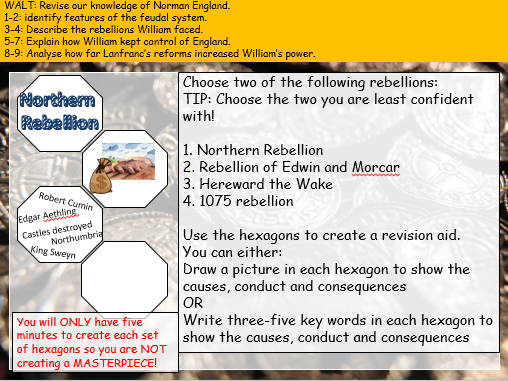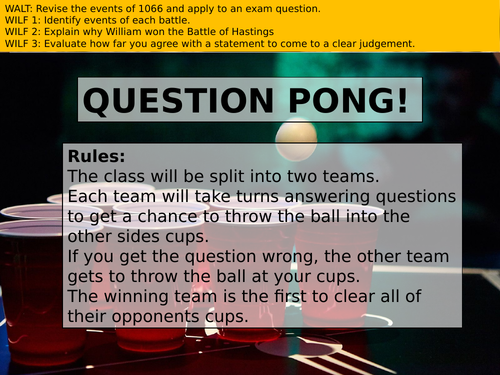
177Uploads
74k+Views
23k+Downloads
All resources

Edward the Confessor (Edexcel 9-1: Anglo-Saxon and Norman England)
This lesson is designed as a skills building case study to help introduce the Normans unit.
Pupils will be introduced to life in Saxon England and the power of the house of Godwin.
They will build towards answering a how useful question to embed paper one and paper three skills.
Gives later opportunity to compare when analysing the control of William. Edward didn’t raise taxes or take land from the earls, so a good link to allow pupils to understand why Saxons were so upset and angry following 1066.

The Power of the Godwin Family and Normandy Embassy (Anglo-Saxon and Norman England (Edexcel 9-1))
WALT: Evaluate the power of the Godwin family.
2-3: Recall key facts about the Godwin family.
4-5: Describe the importance and power of the Godwins in England.
6-7: Explain what happened during Harold’s embassy to Normandy and why it might cause problems.
8-9*: analyse how useful Norman sources are to a historian.
Pupils examine the power of the Godwins and how their influence both helped and hindered Edward’s rule
They then explore the Normandy embassy using the Bayeux tapestry and the Norman and Saxon interpretation of the event.

The Battle of Stamford Bridge (Anglo-Saxon and Norman England (Edexcel 9-1))
WALT: Examine the events of the Battle of Stamford Bridge and evaluate its significance.
1-2: Identify pros and cons for Harold travelling to York.
3-4: Describe the events of the Battle of Stamford Bridge.
5-7: Explain why Harold was able to claim victory.
8-9: Evaluate the significance of the Battles of Gate Fulford and Stamford Bridge.
Pupils evaluate whether Harold should have travelled to York before watching a video that examines the events of Stamford Bridge (Video worksheet included) they then explain the main reason that they think Harold won the battle before evaluating the impact the battle may have on the Battle of Hastings.

End of unit consolidation, mock, and improvement lesson (Edexcel History American West 9-1)
Consolidation:
Pupils will match up key acts and treaties as a quick recall activity
Then they will create two narrative account timelines for Mormon and Exoduster movements.
Consider consequences of the Gold Rush before explaining in detail why each feature of the Boom Towns lead to law and order problems.
Finally, pupils will evaluate how far things had changed for the Indians using acts and treaties to explain whether there were any significant turning points.
Mock attached, follows next lesson.

I'm a Historian! Ice Mummies Investigation (What is history? (KS3))
This lesson is set up as a pupil led investigation, pupils explore the ‘cave’ to find as much evidence as possible before they run out of time. They then have to use they evidence they have been able to collect to work out what has happened to the Mayan ice mummmy - this lesson is part of a series of lessons that build upon use of sources, interpretations and finally a baseline assessment. These can be found separately or as part of a bundle in my tes shop.
WALT: Investigate the mystery of the ice mummies to come to a conclusion.
L3: identify questions historians need to ask in order to learn about the past.
L4-5: describe key features of the ice mummies and explain what you can learn about the ice mummies from the sources and what clues might mean.
L6: hypothesise what might have happened to the ice mummies.
L6: Create a narrative account analysing the experiences of the Ice Maiden and how she felt.

Source utility (What is history? (KS3))
This lesson builds on knowledge gained during the BIAS (WHAT IS HISTORY (KS3)) lesson which is available in my TES shop.
WALT: use sources to explore Mayan culture and explain how they are useful to a historian.
L3: Recall key facts we learnt last lesson about the Mayans.
L4: describe two things you can infer from a source.
L5: explain why sources written by the Spanish are limited to a historian.
L6: Evaluate sources written by the Spanish to explain why they are useful as well as limited.
Pupils use sources to develop skills to analyse utility. Pupils are provided by WAGOLLs and heavy support to enable them to access the skill - worksheets are available for LA, MA and HA.

End of Unit Consolidation (Edexcel 9-1: Anglo-Saxon and Norman England)
This lesson has been designed to be delivered at the end of the unit prior to assessment.
My class has a range of pupils targeted from grade 2-9, therefore my lessons are differentiated with this in mind at all times.
Pupils:
identify features of the feudal system through a starter activity
Describe the rebellions William faced (video and then hexagon revision activity)
Explain how William kept control of England (fully differentiated table, method of control and how it helped him keep control)
Analyse how far Lanfranc’s reforms increased William’s power (colour coding task, differentiated challenge for grade 4-6 and grade 7-9)

Baseline Assessment (What is history? (KS3))
This baseline assessment follows the conclusion of the ‘What is history’ scheme of work that can be found in my tes shop. It is set up to mimic the question types of Paper 3 Edexcel 9-1.
This assessment includes all interpretation type questions - 3b, 3c, 3d.
Bundle

Edexcel 9-1: Anglo-Saxon and Norman England
A bundle of fully differentiated lessons.
Lessons build into a scheme of work for Paper Two Anglo-Saxon and Norman England.
Pupils are given the opportunity to be supported through effective differentiation every lesson and challenged through tasks ranging up to a grade nine every lesson.
There are a variety of WAGOLLs included to give pupils model answers to work from, all tasks are responded to through AFL and there are several longer written responses included to allow teachers to mark pupils written communication.
I have included some revision sessions (labelled REVISION) as a bonus.

The Weimar Constitution (Weimar and Nazi Germany (Edexcel 9-1))
This lesson is part of a unit of work that explores Paper Three, Weimar and Nazi Germany.
Pupils will:
Identify the meaning of the word constitution (using a Freya Model grid)
Describe what the constitution consisted of (see capture, paired task - version of worksheet as a gap fill for lower ability students)
Explain the advantages and disadvantages of the constitution - includes AFL on slide
Develop use of judgement: includes WABOLL, structure strip for LA and differentiated task.

The Lean Years 1924-28 (Weimar and Nazi Germany: Edexcel 9-1)
WALT: Evaluate why the Nazi Party only received 2.6% of the vote in 1928.
Identify the meaning of the phrase ‘ Lean Years’.
Describe features of the period 1924-28.
Explain why circumstances in Germany lead to little support for the Nazis.
Evaluate why the Nazi Party only received 2.6% of the vote in 1928.
Starter: Pupils complete a freya model with the meaning of 'lean years’
Task one: Describe features of the period 24-28 - pupils complete a carousel task, differentiated worksheet and answer sheet provided
Task Two: Explain why circumstances in Germany lead to little support for the Nazis (see cover photo for activity), WAGOLL and answer slide provided to go through with pupils
Task three: Evaluate why the Nazi’s received 2.6% of the vote: Explain why exam question with sentence starters for PEEL structure.

Weimar Germany The 'New' Woman
Fully differentiated lesson about the New Woman in Nazi Germany
Students will:
WALT: evaluate how far women’s lives improved in the 1920s.
Identify visual changes to women by 1925.
Describe how areas of women’s lives changed.
Explain how society reacted to these improvements for women.
Evaluate how far you agree with a statement.
Students complete the screenshotted task before analysing a how far do you agree statement using a ‘agree’o’meter’.
Students are also given the opportunity to look at source work and analyse whether the changes were positive or negative for women.

Treaty of Versailles (Weimar and Nazi Germany: Edexcel 9-1)
Students will:
Identify the terms of the treaty of versaille watching a video and completing a worksheet
Describe whether the terms were fair - guided think pair share activity
Explain how to answer question 3d through use of examiners mark schemes
criticise a model answer to demonstrate what their own work should include
attempt a PEEL paragraph of their own using an interpretation.

Treaty of Versailles: sources group work/how useful (Weimar and Nazi Germany: Edexcel 9-1)
This follows a lesson I have posted about the Treaty of Versailles.
Pupils will examine sources in small groups through use of a carousel activity where each group adds to the last groups ideas (making it harder as they progress around the room and meaning they have to pick out smaller features of sources).
They will then use this skill to analyse a skill themselves, before feedback to the class (AFL slide included).
Following this pupils attempt a fully differentiated how useful question with options for two different structure strips and either two sources or one.
Once completed pupils peer assess their work to explain what is good about their work and how they can move forwards next time they see that question type.

Controlling Religion (Weimar and Nazi Germany: Edexcel 9-1)
WALT: Analyse how far Hitler succeeded in controlling religion.
Identify Hitler’s early policy towards the Church in the Enabling Act.
Describe how Hitler hoped to control the Catholic and the Protestant Church.
Explain why not everyone accepted Hitler’s policies about religion.
Analyse a source to explain how useful it is to a historian examining the catholic response to Hitler’s reforms.
Task one: pupils examine a source from the Enabling Act explaining how Hitler wanted his relationship to look with the church and make an inference
Task two: Carousel activity - how did Hitler gain control of the church? was there any immediate opposition (covered in more detail in a church opposition lesson).
Task three: how far did Hitler succeed in controlling the church? discussion
Task Four: How useful question including structure to guide weaker pupils and key words to prompt focus on knowledge and judgement. Full mark answer accompanies so that you can go through expectations for the 8 mark question with pupils and allow them to self assess and improve their own work based on the example.

Spartacist Uprising and Kapp Putsch (Weimar and Nazi Germany: Edexcel 9-1)
Pupils will:
WALT: Examine challenges to the Weimar government by the left and right.
Identify features of left and right wing politics.
Describe the Spartacist Revolt and the Kapp Putsch.
Explain why Germany was weak after the attacks.
Analyse a source to explain why it is useful.
Included is a fully differentiated how useful question including differentiated structure strips.

How useful (skills builder/revision lesson) (WW1 Medicine on the Western Front: Edexcel 9-1)
THIS FULLY DIFFERENTIATED LESSON HAS BEEN PLANNED TO FIT HALF WAY THROUGH THE WW1 MEDICINE UNIT (AFTER THE CHAIN OF EVACUATION) BUT WILL ALSO BE DELIVERED AS A REVISION LESSON AT THE END OF THE COURSE TO CURRENT EXAM CLASSES.
I HAVE USED MY KNOWLEDGE AS A PAPER THREE MARKER TO CREATE A ‘HOW TO GUIDE’ FOR ANSWERING THE 8 MARK UTILITY QUESTION.
WALT: explore the key skills needed to reach full marks on a how useful question.
Recall the stages of the chain of evacuation.
Describe how to structure a how useful question using the mark scheme.
Explain how useful a source is to a historian enquiring about the chain of evacuation.
Analyse our work using the mark scheme to identify successes and targets.
task one: pupils put the chain of evacuation into order and describe each stage using key words only
task two: pupils annotate a mark scheme, can be done under a visualiser, using the same method as the examiners of paper three (Judgement, analysis, knowledge) discussion with pupils about what key things mean within the mark scheme.
task three: pupils annotate the sources in pairs, question prompts on the board to support less able (underline three key facts etc) before going over it on the visualiser
task four: Pupils answer a how useful question in timed conditions - this can be marked or I have included a peer/self assessment activity where pupils mark their own work and improve it using colour coding and a full mark answer.
i have included a worksheet summarising the chain of evacuation in case this is being used as a revision lesson rather than within original teaching - this may be useful for lower ability pupils within a normal scheme of work as well.

REVISON 1066 with 'Question Pong' game and exam skills (Edexcel 9-1: Anglo-Saxon and Norman England)
WALT: Revise the events of 1066 and apply to an exam question.
WILF 1: Identify events of each battle.
WILF 2: Explain why William won the Battle of Hastings
WILF 3: Evaluate how far you agree with a statement to come to a clear judgement.
As with all of my revision lessons this lesson is accompanied by a single A3 sheet so that pupils do not require exercise books.
task one: identify key events of each battle by labelling key features
task two: question poing - 15 questions covering claim to the throne, Gate Fulford, Stamford Bridge and Hastings
Task three: scales task planning 16 mark question
task four: How far do you agree question with focus on integrated judgement (pictured)

REVISION GAME Question Pong 1066 (Edexcel 9-1: Anglo Saxon and Norman England)
Based on the game 'Beer Pong’
Rules:
The class will be split into two teams.
Each team will take turns answering questions to get a chance to throw the ball into the other sides cups.
If you get the question wrong, the other team gets to throw the ball at your cups.
The winning team is the first to clear all of their opponents cups. (and will receive haribo/chocolate)
the resource includes questions that fly on and off screen - the answers to the questions are in the notes sections.

REVISION Rebellions and exam skills (Edexcel 9-1: Anglo Saxon and Norman England)
WALT: Revise the rebellions against William and evaluate how big of a threat they made towards his reign
Identify reasons people were upset with William’s leadership
Describe each rebellion.
Compare rebellions to explain how William responded to each threat.
evaluate how far you agree with a statement to come to a clear judgement
As with all of my revision lessons the worksheets cover all tasks so that pupils do not require their exercise books.
Task one: what did people have to be unhappy about?
Task two: Video task
Task three: line task (pictured as cover image) alongside information sheet to help pupils remind themselves of key content.
Task four: Exam question from past paper fully planned on slides to support pupils




















